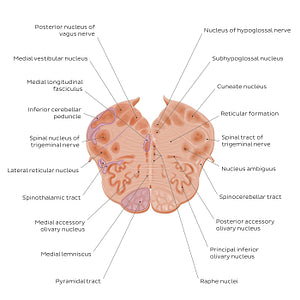Paul Kim
Medulla oblongata: Vagus nerve level (English)
Medulla oblongata: Vagus nerve level (English)
At this level, the central canal opens into the fourth ventricle, forming the superior or open medulla oblongata. A part of the vagus nerve can be seen extending from the dorsal nucleus of the vagus nerve, while the remainder arises primarily from the nucleus ambiguus. Medial to the dorsal nucleus of vagus nerve are the nucleus of the hypoglossal nerve and subhypoglossal nucleus (of Roller). Laterally, the nuclei of the posterior funiculus terminate in order to make room for the medial vestibular nucleus. The inferior cerebellar peduncle begins to appear at this level and is surrounded by many nuclei. A prominent feature of this level is the large reticular formation, which lies anterior to the hypoglossal and dorsal vagal nuclei, lateral to the medial longitudinal fasciculus and tectospinal tracts and overlaps the nucleus ambiguous. At this level, the principal inferior olivary nucleus begins to expand resulting in an external prominence on the anterolateral surface of the medulla oblongata known as the olive. The medial and posterior accessory olivary nuclei can be identified medial and posterior to this structure. Towards the midline of the medulla oblongata, decussating fibres of the medial lemniscus form a seam known as the raphe. On either side of the raphe are a cluster of neurons, the raphe nuclei, which belong to the reticular formation of the medulla oblongata. The medial longitudinal fasciculus can also be identified along the raphe. This white matter tract ascends through the brainstem along its dorsal midline, while the spinothalamic and spinocerebellar tracts maintain their anterolateral position, just dorsal to the olive.
Normaler Preis
$7.56 USD
Normaler Preis
Verkaufspreis
$7.56 USD
Grundpreis
pro
Verfügbarkeit für Abholungen konnte nicht geladen werden


#C75926
#A26F58
#AE5A2F
#694736
#EFB394 und #D6AEB0

